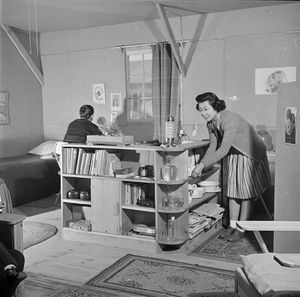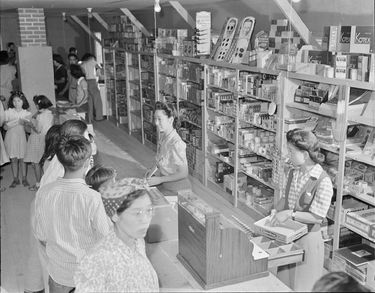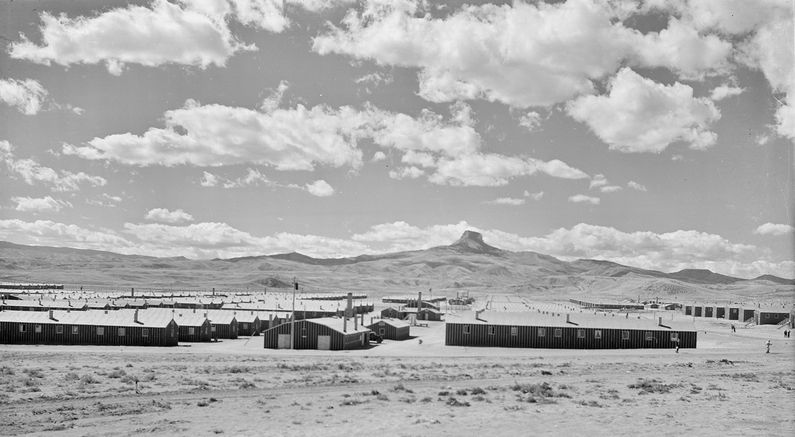Heart Mountain War Relocation Center
|
HistoryEstablished in Jun 1942, and was built by More than 2,000 laborers, including men employed by the Harza Engineering Company of Chicago and the Hamilton Bridge Company of Kansas City. Work began on June 8, under the direction of the Army Corps of Engineers. The center became the Heart Mountain War Relocation Center run by the civilian War Relocation Authority (WRA). The estimated cost of construction was $ 5,095,000. The ten relocation centers were not considered by authorities to be either concentration camps or internment camps but the perception was otherwise. Barbed wire fencing enclosed most of the living area, the guard towers with searchlights and the military police were always visible.
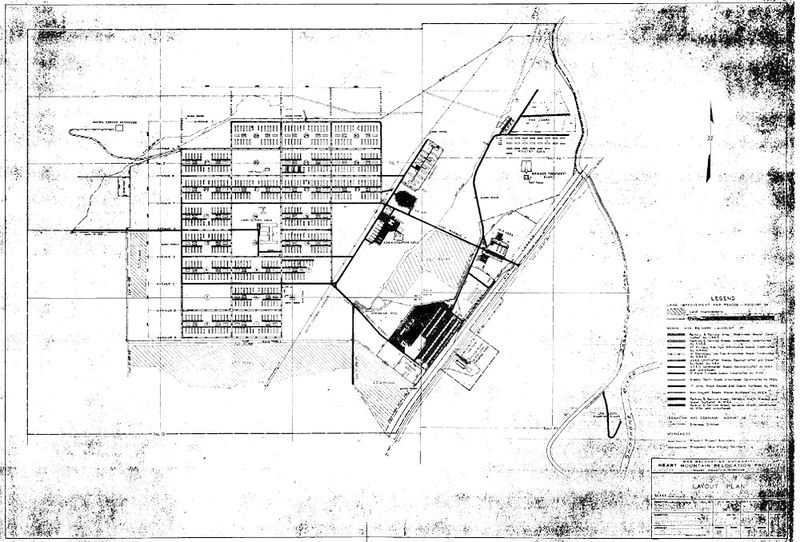
Residential Areas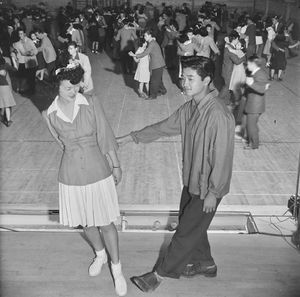 Facilities at the center included 30 residential blocks with 20 barracks blocks and 10 vacant blocks designated for recreation/garden use. The 20 barracks blocks differed from the other centers because each block had 24 barracks instead of 12 and each barracks building was twice as long, 20' by 200' instead of 20' by 100'. Each barracks block had six service buildings. The service buildings included two 40' by 100' mess halls, two 20' by 100' recreation halls, and two combined laundry/latrine buildings. These buildings were all temporary military style Theater of Operations (TO) structures of wood frame construction with tar paper covering the outer walls and roof.
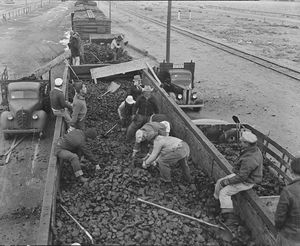 Each barracks block could house some 500 residents with the communal mess halls and latrine facilities in each block. There were no cooking facilities or running water in the barracks buildings and electric power was meant only for lighting. The Center was one of just a few communities in the state to even have electricity. The area was hot in the summer and very cold in the winter and temperatures dropped to 28 degrees below zero the first winter. Heating was provided by coal-burning stoves in each partitioned apartment. Coal was brought in by rail and distributed to each family by residents employed to do so.
Other Facilities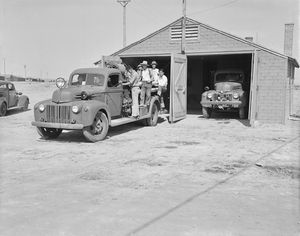 Other facilities at the Center included most of the infrastructure that would be required for any town of 10,000. The administrative area included admin buildings, a town hall, post office, mess hall, police station, and staff housing. There was a warehouse group & motor pool group. Other groups included a Hospital and fire protection. Agricultural facilities included a hog farm and chicken ranch as well as crop fields. The military police provided external security while a Heart Mountain WRC police force made up of residents handled police duties inside the Center.
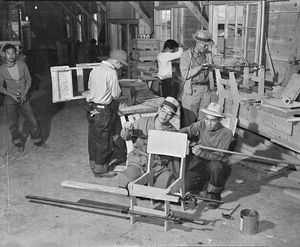 Schools were not specifically provided for and initially vacant Center buildings were used for classrooms which were clearly inadequate. Residents began construction of schools and set up shops to build furniture for the classrooms and facilities. The high school was the largest project and it was completed on 27 May 1943, less than a year after the Center opened. Teachers were hired from the resident community and from outside the Center. Three Enterprise stores were established by the WRA in the Center as a part of a co-op to provide sundry items and services including canned goods, newspapers and magazines, toilet articles, ice cream, soft drinks, and candy. Services included barber shops, a beauty shop, a fish store, and a laundry and dry cleaning services were established by Community Enterprises. In three years of operation, the co-op did $ 2,500,000 worth of business.
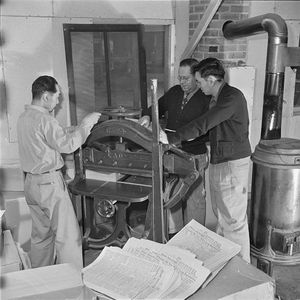 The first edition of the Center's newspaper, the Heart Mountain Sentinel was printed on 24 Oct 1942 and was distributed every Saturday until the summer of 1945. The newspaper was published by residents in English with a handwritten Japanese language section. The paper covered topics ranging from camp activities and events to editorials voicing concerns of the internees.
ProblemsAs with the other relocation centers, there were problems over and above those created by the forced evacuation to the center. The decision that no Japanese-American worker could be paid more than an Army private ($21 a month) created a universal problem at all the relocation centers. It meant that Caucasian teachers at the school might be paid $150 a month while a Japanese-American teacher might be paid just $19 a month. Caucasian nurses were paid a starting salary of $150 a month while Japanese-American physicians could only earn $19 a month. Wages for Japanese-American workers were set at $12 monthly for an unskilled laborer, $16 for skilled laborers and $19 for professionals. In Heart Mountain WRC this inequity resulted in many labor disputes, work stoppages and other protests including coal loaders strike in November 1942 and hospital workers strike on 24 Jun 1943. Another major issue revolved around a questionnaire used to identify disloyal residents that was poorly worded and left some Japanese-Americans unable to respond affirmatively to two questions. A negative response to these questions classed the individual as disloyal and could result in them being relocated to Tule Lake Maximum Security Segregation Facility or jailed. The questionnaire and segregation soon became one of the most divisive events of the entire relocation. The situation got worse when the Government reinstated the draft for the Nisei on 20 Jan 1944 and open resistance to the draft resulted. In all, 85 residents at Heart Mountain were convicted of draft evasion and were sent to federal prison. In spite of the substantial draft resistance at Heart Mountain, 700 men reported for their selective service physicals and 385 were inducted. Most of the Japanese-American volunteers and draftees became part of the 442nd Regimental Combat Team, the most decorated unit of its size and length of service in American history. The 442nd received 18,143 individual decorations and had 9,486 casualties in a regiment with an authorized strength of only 4,000 men. Closure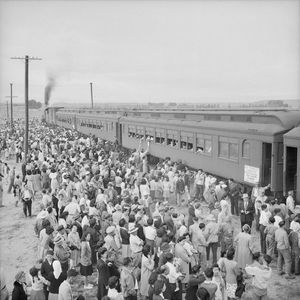 Closed on 10 Nov 1942 when the last evacuee departed after some 39 months of operation.
Current StatusNow part of Heart Mountain National Historic Landmark. The Heart Mountain Wyoming Foundation gained National Historic Landmark status for the site on 20 Sep 2006 and on 20 Aug 2011 opened the Heart Mountain Interpretive Center. Visitors can take a walking tour of the site and its remaining structures. The 30-minute walking tour includes the sites and remains of the hospital complex, the Military Police station & guard tower, Root Cellars, swimming hole, admin area, barracks area, high school, and the Center support facilities. Former U.S. Secretary of Transportation Norman Y. Mineta and retired U.S. Senator Alan K. Simpson, who met as Boy Scouts on opposite sides of the barbed wire fence surrounding the Heart Mountain compound, act as Honorary Advisors to the Foundation. The Foundation hosts an annual pilgrimage at Heart Mountain, the first of which coincided with the Interpretive Center's 2011 opening.
See Also: Sources:
Links:
Visited: 13 Jul 2019
| |||||||||||||||||||||||||||||||||||||
